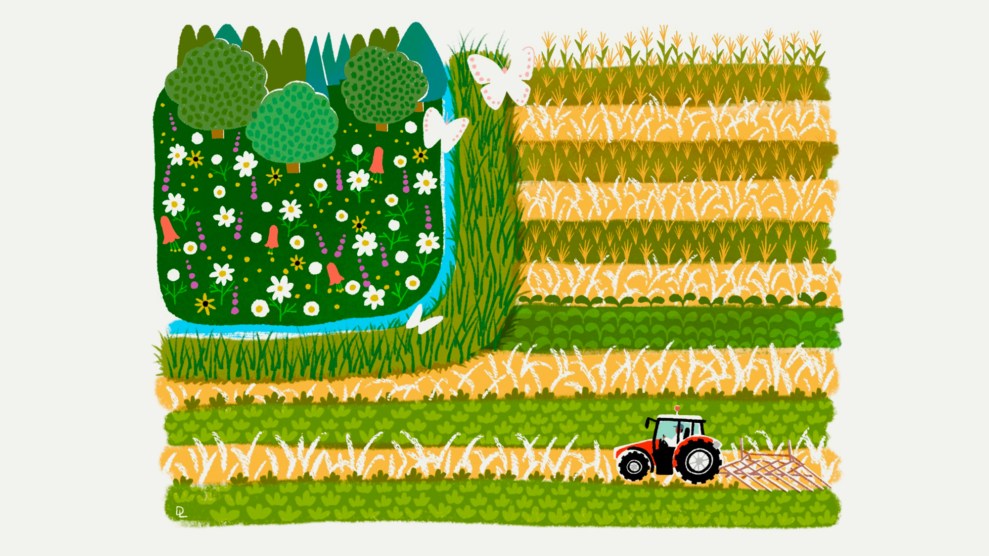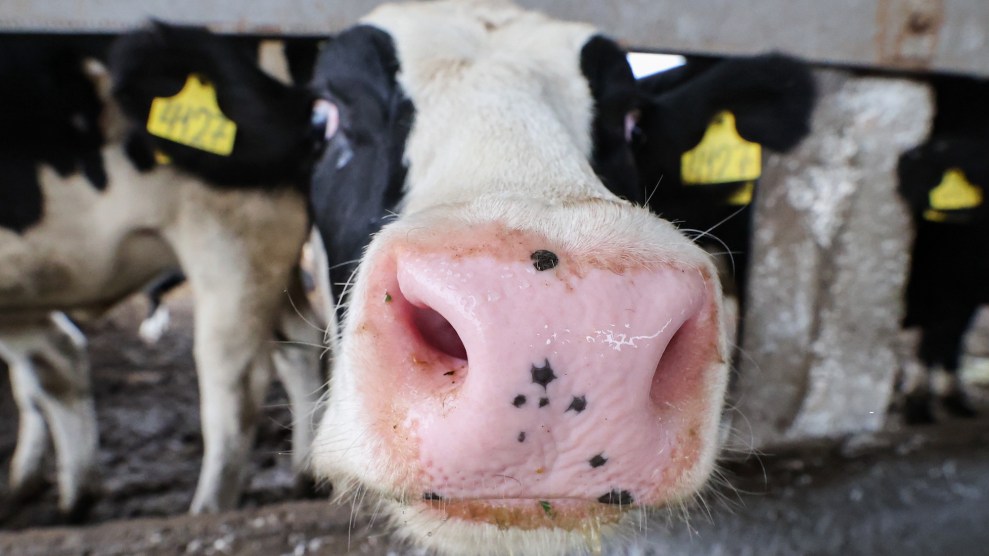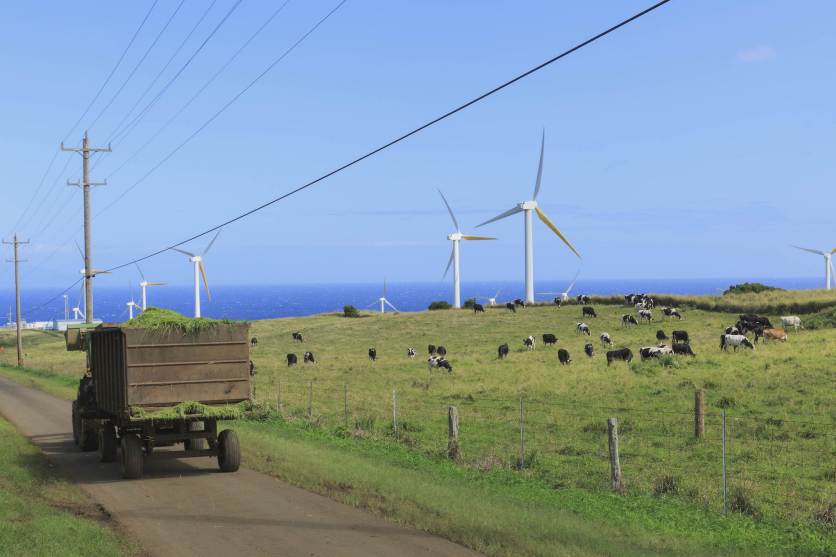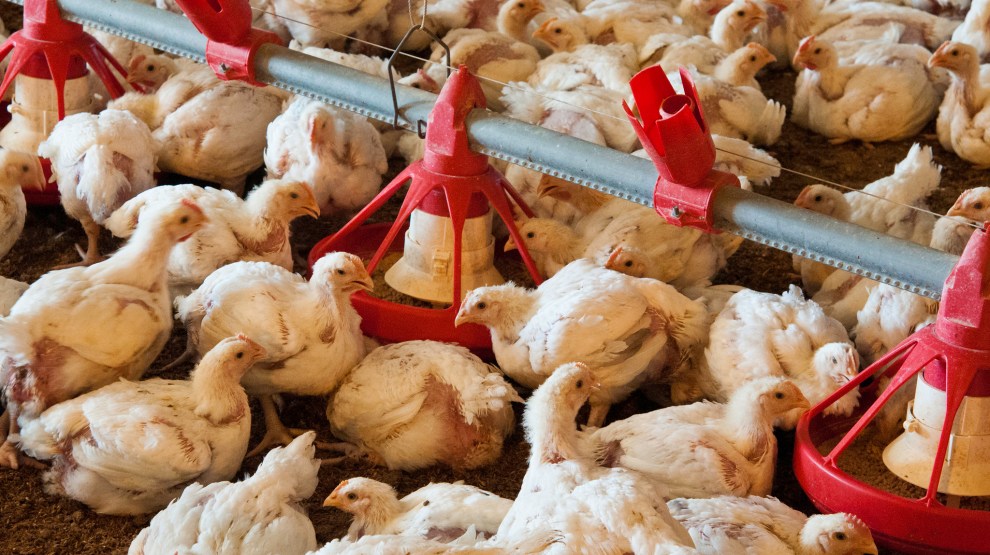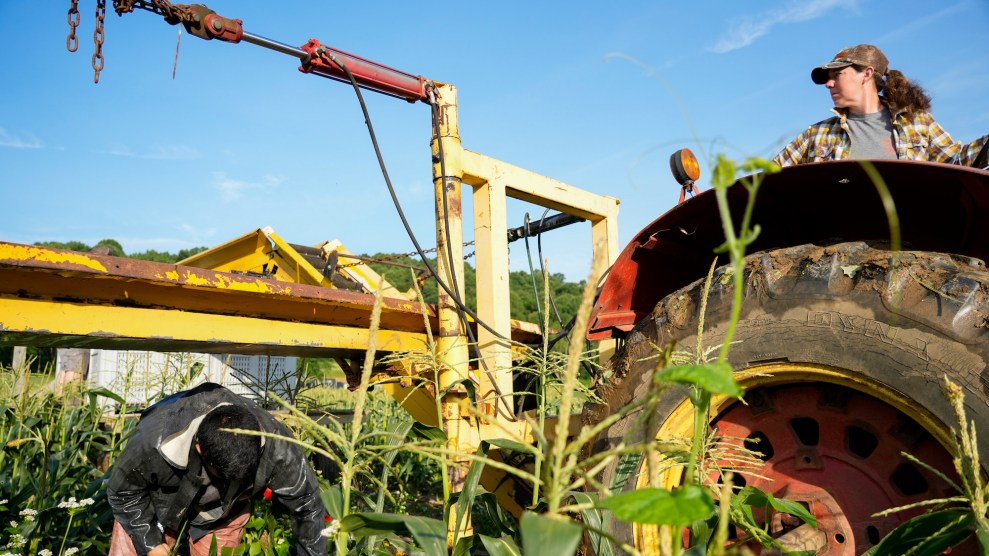
Farmworkers picking up sweet corn in a Ohio field. Joshua A. Bickel/AP
This story was originally published by Inside Climate News and is reproduced here as part of the Climate Desk collaboration.
On Tuesday, Agriculture Secretary Tom Vilsack helped unveil his agency’s Census of Agriculture, a huge quinquennial report that covers 6 million data points and gives the current state-of-the-state of American farms and farmers.
In a presentation at the Department of Agriculture (USDA), Vilsack underscored his main takeaway: The number of American farms and farmers continues to decline, a fact that has broad consequences, he argued, beyond farming itself.
“I’m concerned about the state of agriculture and food production in this country,” he said, before ticking off a few numbers to make his point.
In 2017, the year the previous report covered, the country had 2,042,220 farms. In 2022, it had 1,900,487. In that same span, the number of farmed acres dropped from almost 900 million acres to 880 million—a loss in area the size of all the New England states, minus Connecticut, Vilsack noted.
The drop, Vilsack argued, has caused ripple effects across rural America, resulting in the loss of schools, businesses and healthcare infrastructure, and the overall hollowing out of farming communities.
One way to reverse the trend, he said, is to boost support for agricultural methods and practices that have climate benefits so farmers can earn money for them.
“It’s important for us to invest in climate-smart agriculture,” Vilsack said, “because that creates an opportunity for farmers to qualify, potentially, for ecosystem service market credits, which is cash coming into the farm for environmental results that can only occur on the farm. The farm then creates a second source of income.”
In other words, Vilsack argued, climate action could help save the American farm.
The problem, the census data suggest, is that American farms, especially big factory farms that generate significant greenhouse gas emissions, are growing in size. The data also show that, overall, more government support is flowing to larger or more profitable operations. According to the census, these farms are using more of the precious and drought-depleted water supplies that climate change is projected to deplete even more, especially in the West.
“This tells a compelling story, across all of these things,” said Anne Schechinger, the Midwest director of the Environmental Working Group (EWG). “It’s a clear picture that these larger farms are doing the best and are benefitting the most from government policies.”
Researchers and advocacy groups pored over the data after it was released Tuesday afternoon, trying to tease out trends.
The number of cattle, the biggest source of agricultural greenhouse gas emissions—both from burps and manure storage—actually went down by 5.6 million over the 2017 census. But the number of cattle in large dairies and feedlots—and the overall number of larger dairies and feedlots—went up.
An analysis of the data by the advocacy group Food & Water Watch found the number of animals raised on large, factory-scale farms rose by 6 percent over 2017 and by 47 percent over 2002. That translates to more animals in concentrated areas, generating more manure that’s disposed of in pits and lagoons where it emits more methane, an especially potent greenhouse gas.
“We haven’t seen a huge difference in the number of dairy cows,” said Amanda Starbuck, the group’s research director. “But because there’s a shift to these big facilities, we’ve seen an increase in emissions from manure management.” (According to the Environmental Protection Agency’s most recent Greenhouse Gas Inventory, methane emissions from manure management rose from 39 million metric tons in 1990 to 66 million in 2021. When animals are raised on pasture, their manure releases very little methane.)
The EWG analysis found similar trends. The number of the largest cattle farms—those with 5,000 or more cattle per farm—has grown from about 1,100 in 2012 to just under 1,450 in 2022, an increase of nearly 30 percent. Of the “Big Three” livestock—cattle, chicken and hogs—the number of animals produced in the largest farms also went up, by about 28 percent for cows, and 24 percent for hogs and chickens.
As for farm economics, Schechinger noted that the most recent income data suggest that farmers are actually doing pretty well and that farm income is roughly at its 20-year average.
“Farmers don’t need more sources of revenue,” she said, referring to Vilsack’s comments. “They’re already getting subsidies and crop insurance, not to mention we have high farm incomes generally.”
Schechinger’s analyses in the past have found that much of the money the Agriculture Department spends on conservation tends to flow to big-ticket items, such as irrigation systems and methane digesters, which generally go to bigger farms.
“Conservation money shouldn’t be viewed as a revenue generator,” she added. “It should be viewed as having a climate benefit for the taxpayer money.”
In his presentation Tuesday, Vilsack referred to the agency’s push to build voluntary carbon markets in which farmers get paid for practices—planting cover crops, stopping tillage and employing so-called adaptive grazing—that sequester carbon or limit emissions. Polluters seeking to offset emissions then purchase those credits.
The Biden administration has attempted to make farmers central in its efforts to reduce greenhouse gas emissions and has directed nearly $20 billion to the USDA for climate and conservation programs through the Inflation Reduction Act.
But to some analysts, the new census suggests that agricultural policy continues to enrich the biggest players at the expense of farmers and the climate.
“Vilsack is talking about a system that doesn’t benefit farmers; it benefits big food companies and ethanol producers,” said Ben Lilliston, director of rural strategies and climate change at the Institute for Agriculture and Trade Policy. “He’s spinning climate action and is missing some of the lessons of the data that tell us the markets aren’t working. Farmers need to get paid fairly. Farmers are weak players in the market right now. That’s the fundamental problem.”
“We don’t need to create other income streams that others can capitalize on,” Lilliston added, referring to carbon markets. “If farmers are doing things that are climate-smart, they should be paid a premium for it.”
